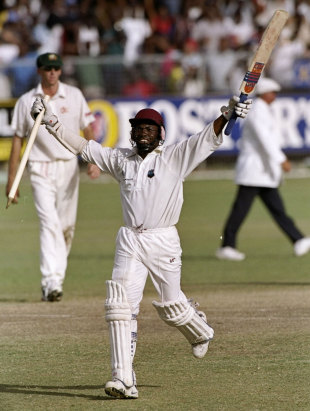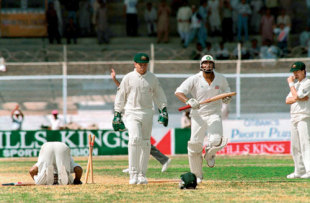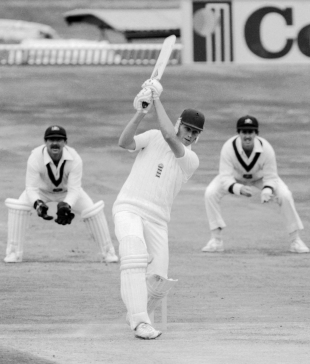|
|
|

Lara's 153 is widely acknowledged as the greatest match-winning innings of modern times, but he couldn't have done it without Courtney Walsh
© Getty Images
|
|
| |
Batting partnerships are a lot like love affairs. As Marvin Gaye and Kim Weston so eloquently put it, it takes two, baby. In both cases, the lasting ones can inspire and transform, even challenge our notions of possibility. For all that we laud those who carry their bat or supply 60% of the runs, one batsman can never save or win a match entirely on his own. Besides, is any sporting act quite so life-affirming as the last-wicket alliance that turns impending defeat into improbable victory or honourable draw?
The present and extremely recent past certainly have plenty to brag about. Over the past three years, three of the Test records for the top four wickets have fallen (six of the tallest 13 stands, in fact, have been recorded since the start of 2003, including the first in professional annals to scale the giddy heights of 600). The past three months alone, moreover, have produced an extraordinary array of dangerous liaisons.
In Karachi, Mahela Jayawardene and Thilan Samaraweera erased Peter May and Colin Cowdrey's 52-year-old Test record for the fourth wicket.
In Perth, AB de Villiers and JP Duminy put on 111 for the fifth, steering South Africa to the second-highest successful chase in five-day annals. In the very next Test,
in Melbourne, Duminy and Dale Steyn added 180, just 16 shy of a fresh peak for the ninth wicket.
In Antigua, West Indies' final pair, Fidel Edwards and Daren Powell, denied England by surviving the last 10 overs.
In Johannesburg, another debutant, Marcus North, added 117 with Mitchell Johnson for the eighth wicket against the game's mightiest pace attack, paving the way, ultimately, to a victory predicted by few outside the tourists' dressing room.
In Lahore this week, Samaraweera even managed to co-author consecutive 200-run stands in the same innings.
For all the indelibility of the really big numbers (Sangakkara and Jayawardene's 624, Jayasuriya and Mahanama's 576, Laxman and Dravid's 376) and the legendary ones (Watson and Bailey's 163, Hirst and Rhodes' 15), assessments of worth are about far more than mere number-crunching. That Edwards-Powell duet, after all, weighed in at just 17 runs. No less marvellous was that last-ditch Robert Croft-Angus Fraser double-act against South Africa
at Old Trafford in 1998, which yielded all of two runs, yet managed, over the course of 5.1 overs, three of them hurled down by Allan Donald, to ensure just the second draw-with-the-scores-level in Test history, keeping the tourists' series lead at 1-0. Duly emboldened, England took the next two matches to gain their first triumph in a five-Test rubber for more than a decade. Then there was the Alan Knott-Jeff Jones Show
in Georgetown in 1968, which did not even trouble the scorers. A devout No. 11, Jones withstood the entire final over, bowled by Lance Gibbs, the planet's premier spinner; the day was saved and the series was England's.
Context is everything. No partnership, for instance, raises the hairs on the back of the neck quite so efficiently as the one between Bert Sutcliffe and Bob Blair
in Johannesburg 54 Boxing Days ago. Sutcliffe had retired hurt after being skulled by Neil Adcock; by the time New Zealand's ninth wicket fell his head was swathed in bandages, his torso festooned with bruises, the follow-on heroically saved, innings over. Blair, after all, was not due to come in at all. That morning he had learned that his fiancée had died in a train crash back home, a national disaster that cost 150 other lives. Yet not only did Blair go back on his apparent decision to withdraw from the contest, he helped Sutcliffe add 33 in 10 minutes of joyous mayhem. The impact on the match was less than negligible - it was lost by 132 runs - but the memory endures even for those who never saw it.
Then there are those partnerships whose value and stature are severely undermined by what happened next. But for a hotly debated caught-behind, Brett Lee and Michael Kasprowicz might well have pulled off the not inconsiderable feat of concluding the 2005
Edgbaston Test with a stand of 62, the highest ever last-wicket liaison to win a Test; instead, they fell three short.
In Durban, in a match that began 70 years ago this week, Paul Gibb and Bill Edrich came together with England, set the small matter of 696, on 78 for 1. Gibb was playing in his debut series; Edrich's first-innings single had left his Test CV reading 88 runs in 11 knocks - highest score 28. Undaunted, the pair added 280, Edrich went on to 219, and England were only 42 short with five wickets intact when the tourists were forced to hurry away to catch the boat home.
Nominating Test cricket's most stirring partnerships, then, is as fiendishly ticklish a proposition as it is subjective. Here, nonetheless, in ascending order, is your starter for 10. Given the timeless allure of the tail-end rally, orchestrated as it invariably is by at least one partner with few if any pretensions towards professional batsmanship, timing takes precedence over volume.
|
|
|

Inzamam seals the deal with four leg-byes, in Karachi, 1994
© Getty Images
|
|
| |
5) Inzamam-ul-Haq and Mushtaq Ahmed, Karachi 1994
But for the suspicions aroused in hindsight - it was the dawn, after all, of the match-fixing era, and too many of the combatants here would be tarred with that wayward brush - this would have come higher. What cannot be disputed is that the 57 Pakistan's last pair put on remains the largest 10th-wicket stand to win a Test. Entire teams have been dismissed for less.
When Shane Warne sent back Waqar Younis, his fifth victim of the innings, to leave the hosts on 258 for 9, Mushtaq joined Inzamam with the Australians convinced, not unnaturally, that the fat lady was clearing her throat and counting her chickens. Instead, the duo repelled everything Warne buzzed at them and took due toll of an otherwise largely unassuming attack (featuring Jo Angel, Tim May, a pair of Waughs and a green Glenn McGrath). They knocked off the needful in just 42 minutes, Mushie's unbeaten 20 off 30 balls his highest score in 22 Test innings to date. "God is great," chanted the crowd. How easily, though, might the result have gone the other way.
Greg Baum's report in the Melbourne Age captured the tingling drama of the final ball: "With three needed, Inzamam stepped out to Warne, only for the ball to take a fine deflection from his front pad and run away past wicketkeeper Ian Healy to the boundary rope. Warne appealed for lbw, but umpire Dickie Bird was already signalling four leg-byes…" Inzy hoisted his arms in triumph - he would later state that it felt even better than playing the innings that won the 1992 World Cup; Healy took his wrath out on the stumps. Nobody, happily, blamed him for the alleged missed stumping, so low did the ball scuttle through (Inzy had expected it to bowl him).
4) Don Bradman and Jack Fingleton, Melbourne 1937
Every year I force-feed my cricket-resistant students this deliciously multi-dimensional slab of history, comfortably the most durable record partnership in Tests. Not because, 72 years on, it remains, at 346, the highest for the sixth wicket, nor even because it launched the greatest fightback in five-day history, but because it came as a direct consequence of one of the most daring ploys in the history of international sport.
By the time a sticky, prickly pitch had done its worst, it had seen off 23 batsmen for 373 runs, yet prompted two declarations, so keen were the captains to subject the opposing order to its treacheries. Bradman, though, had a cunning plan for Australia's second innings: send the bowlers in first. Sure, by the time he entered the fray himself, he'd sacrificed five wickets for 97, the lead a tenuous 221, but conditions had eased appreciably. The Don, though, was in mortal form, having recorded ducks in each of the first two Tests, both lost heavily. Dissent and dissatisfaction over his leadership, meanwhile, were growing at an alarming rate. He was also suffering from a nasty chill.
"Everything depended on Bradman," reckoned Neville Cardus, "and he knew it." A shower came and went, then another; the umpires "wandered to and from the pavilion's direction like people lost in the Hampton Court maze". When the skies dried, England's bowlers, hampered by sawdust and a sopping ball, lost their grip "on a rich couch stuffed with runs". Fingleton made 136 but Bradman, as was his wont, hogged the scoring on his way to 270: the (then) best for Australia in a home Ashes encounter and still the biggest second-innings stint in the urn's history as well as the highest by any Test No. 7. So bent was he on breaking English spirits, even when he was ninth out, the lead 670, he declined to declare.
"Chuck" Fleetwood-Smith and Bill O'Reilly spun Gubby Allen's men out for 323, the next two Tests were won, too, and the only instance of a side winning a series from two-down was complete. But for Bradman's typically ingenious snook at convention, the revival might have been stillborn.
3) Ken Mackay and Lindsay Kline, Adelaide 1961
Napoleon had his 100 days, Kline his 100 minutes. On the final morning Australia's No. 11, scorer of 43 runs in his previous 15 visitations to a Test crease, had a net against the less than intimidating duo of Johnny Martin and Norm O'Neill. They got him out 11 times. When he went in to bat that afternoon, with 100 minutes left, victory out of sight and defeat all but assured, the attack confronting him featured the contrasting might and flight of Wes Hall, Lance Gibbs, Sonny Ramadhin and Alf Valentine.
|
|
|

Dilley gives it some humpty inspired by Botham at the other end, at Headingley in 1981
© Getty Images
|
|
| |
Richie Benaud was about to have "a leisurely shower" when Kline spotted him en route to the middle, and asked what he should do. "Oh, why don't you just stick around," replied his captain, more in solidarity than hope, much less expectation. By the time he was dressed, Kline's alliance with "Slasher" Mackay, the era's best-known back-to-the-wall grafter, was still in its infancy. Over the remainder of the innings, Benaud recalled lighting 16 cigarettes.
Kline continued, somehow, to cling on. Even when West Indies clamoured for a catch to short mid-off, Mackay refused to budge. The draw, breathlessly, was eventually secured, whereupon the hosts took the similarly exhilarating final Test, by just two wickets, and with it the most resplendent of all series, the series that single-handedly insured Test cricket against extinction until Ian Botham renewed the policy 20 years later.
2) Ian Botham and Graham Dilley, Headingley 1981
Ninety-three behind, three wickets left, hope drawing its final breath. Another Australian victory and they'd be two-up with three to play - the Ashes, to all intents and purposes, in the bag. Such was the somewhat unpromising situation when Graham "Picca" Dilley joined Ian "Lord of the Lads" Botham on the fourth afternoon. "Have you checked out of the hotel yet?" wondered Botham. The young fast bowler had not, deeming it "the wrong thing to do". "I have," proclaimed Botham, "but I forgot to pay the extras bill. I hope I don't have to go back." The game, he added, had "gone". Hence the ensuing rallying cry: "Let's give it some humpty!" Up on the balcony, Dilley, who had cobbled together 11 runs in seven innings in the winter's series against the West Indies, had already agreed a strategy with Chris Old, the next man in - "If it's on the stumps block it. If not, welly it."
And so they did, wellying and humptying 117 in 80 minutes, heedless of bowlers, pitch, restraint or caution, turning red into black. At its heart lay the art of competition. Dilley lit the fuse, scoring 22 of the first 27. "Picca kept hitting so I decided to join in," Botham would explain. Dilley, though, claims it was sheer pique: he was catching the great allrounder up. "I don't think he was that pleased."
Of course, Botham's subsequent stands with Old and Bob Willis, not to mention Willis' onslaught on the final day, were still required to complete the least probable of Test victories, but here was the unwitting inspiration from which all else flowed, conjuring the faintest whiff of hope from a sea of resignation. "The change in the way the Aussies were reacting made you think something was going to happen," Dilley would reflect. "But nobody really pictured what actually was."
1) Brian Lara and Courtney Walsh, Bridgetown 1999
Petite but exquisitely formed: never mind the quantity, feel the fantasy. Admittedly, but for Lara's preceding ninth-wicket stand with Curtly Ambrose, this duet, worth a paltry nine runs, would have been consigned to the distant recesses of the memory instead of standing proudly at the forefront. Pursuing 308 against an attack led by McGrath, Jason Gillespie, Stuart MacGill and Warne, West Indies lost half the order cheaply before Jimmy Adams helped Lara add 133. Then McGrath sent back Adams, Nehemiah Perry and Ridley Jacobs in swift succession, and although Healy dropped Lara, Gillespie unglued the stubborn Ambrose with the score unchanged, bringing in Walsh with six required. To come so close and still lose would break more than just Bajan hearts, but here was a chap with a record 32 Test ducks under his belt.
In all, the porous Jamaican faced just five deliveries from Gillespie and McGrath, one a no-ball and one that counts among the most errant the latter ever served up. Had Walsh succumbed to any of the three legitimate ones he faced in succession from Gillespie, his partner's unconquered 153, by common consent the greatest match-winning innings of modern times, would have been in vain. But he did not, and when Lara drove the winning four, the game was blessed with its feelgoodest, most gloriously Disneyfied denouement.
The greatest match-winning stand, in terms of sheer substance, is surely the 238 by Adam Gilchrist and Justin Langer
in Hobart in 1999: Pakistan (Wasim, Waqar, Shoaib and Saqlain) had removed Australia's top five for 126, yet were prevented from striking again until the target was but five runs distant - and by attack rather than attrition. The Lara-Walsh duet still nourished the romantic soul like no other.
From a neutral perspective, there was another cause for joy. The soccer season was bubbling to its climax, the ICC World Cup weeks away; the latest bulletin on Mike Atherton's back was discouraging and patriotically led the sports pages for the early editions. Yet the Guardian, to its eternal credit, still pushed it downpage to celebrate this major minor miracle. Who says sporting coverage is blinded by national flags?
Rob Steen is a sportswriter and senior lecturer in sports journalism at the University of Brighton


